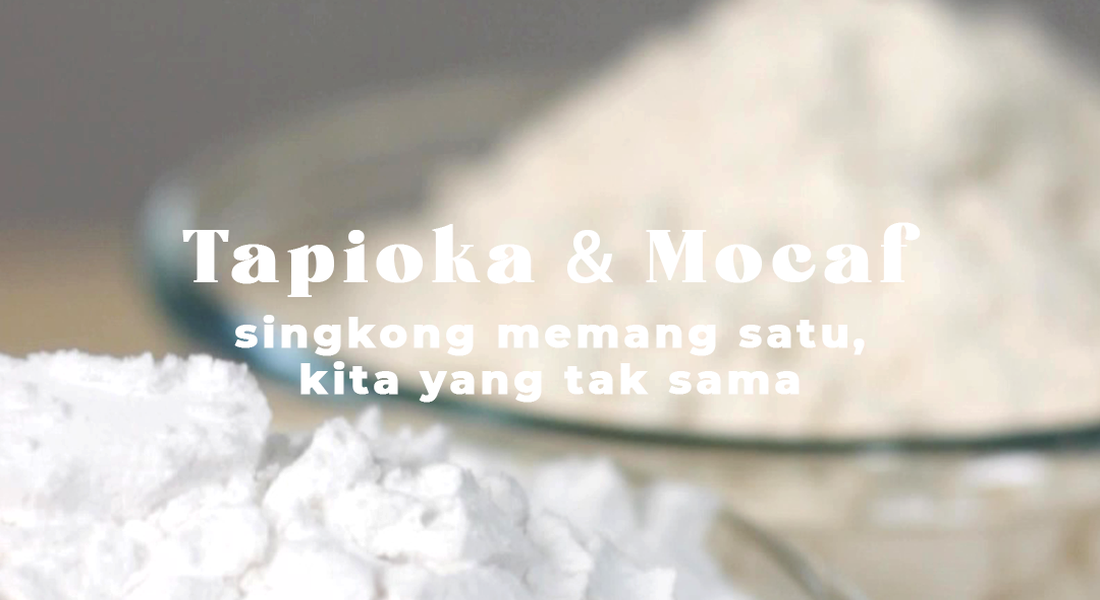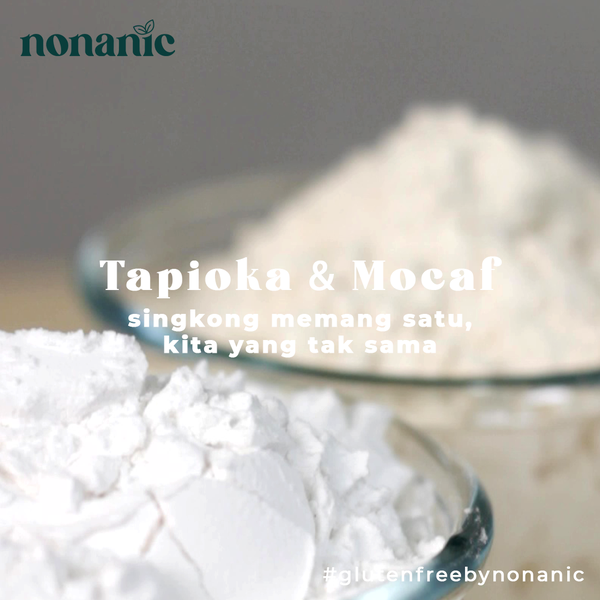
Tapioka VS Mocaf, Apa sih Bedanya?

What’s the Difference Between Tapioca Flour and Mocaf? Let’s Find Out!
Hi BestNic, I’m Cynthia, a baker and gluten-free enthusiast. If you’re still confused about the difference between tapioca flour and mocaf, let me enlighten you.
What is Tapioca Flour?
Tapioca flour is the starch extracted from cassava. In Java, it’s commonly known as kanji flour, and in Sundanese, it’s called aci. Tapioca is obtained through a process where cassava is finely grated, squeezed, and water is added. The starch is then left to settle, and this sediment becomes the flour after it is dried.
What is Mocaf?
Mocaf, or Modified Cassava Flour, is flour made from the entire cassava root. The process of making mocaf is different from tapioca flour. The cassava does not undergo sedimentation; instead, the entire cassava root is modified through soaking for fermentation. After drying, mocaf produces flour that is almost similar to wheat flour.
The Main Differences Between Tapioca Flour and Mocaf
Processing Method
For tapioca flour, cassava is finely grated, squeezed, and water is added. The resulting starch is then settled and dried into flour.
For mocaf, there is no sedimentation process. The entire cassava root is modified through soaking for fermentation. After that, the cassava is dried and processed into flour.
Texture and Aroma
Tapioca flour has a rough texture, similar to sago. So, if you don’t have tapioca flour, sago can be a good substitute. Tapioca flour also tends to be sticky and chewy when processed, making it suitable for making cireng, crackers, and boba toppings.
On the other hand, the fermentation process in mocaf makes the flour softer and free from the distinctive cassava smell. Mocaf also expands more when used in dough, making it a good substitute for low to medium protein wheat flour.
Uses in Cooking and Baking
Due to their different characteristics, tapioca flour and mocaf have different uses in the world of cooking and baking.
Tapioca Flour
1. Cireng: Cireng or fried aci is a popular snack in Indonesia. The sticky and chewy texture of tapioca flour is perfect for making cireng.
2. Crackers: Many types of crackers use tapioca flour as the main ingredient because of its crunchy texture.
3. Boba Toppings: Who doesn’t love boba? The boba toppings in trendy drinks also use tapioca flour because it gives that characteristic chewy texture.
Mocaf
1. Bread: Mocaf can be used as a substitute for wheat flour in bread making. Because mocaf expands more, the resulting bread is softer and fluffier.
2. Cakes and Cookies: Mocaf flour is excellent for making gluten-free cakes and cookies. The results are just as delicious as those made with wheat flour.
3. Fried Foods: Want to make gluten-free fried foods? Mocaf is a great choice because it gives a crispy texture without being greasy.
Why Choose Gluten-Free Flour?
Many people are now switching to a gluten-free diet, whether due to health reasons like celiac disease or gluten intolerance, or for lifestyle reasons. Tapioca flour and mocaf are two great options for a gluten-free diet because they are both gluten-free and offer various health benefits.
Health Benefits
1. Gluten-Free: Of course, the most important benefit is being gluten-free, making it safe for those with celiac disease or gluten intolerance.
2. Low in Fat: Both flours are low in fat, making them suitable for those watching their fat intake.
3. High in Complex Carbohydrates: The carbohydrates in tapioca and mocaf flours are complex carbohydrates, which are good for long-lasting energy.
Tips for Using Tapioca Flour and Mocaf
1. As a Thickener: Tapioca flour can be used as a thickener in sauces or soups. Just add a little water to make a paste, then mix it into your dish.
2. Flour Mixes: If you want to make lighter and less dense cakes, mix mocaf flour with other gluten-free flours like almond flour or coconut flour.
3. Experiment with Recipes: Don’t be afraid to experiment. Every flour has its own characteristics, so trying different combinations can result in unique and delicious recipes.
Now you know the differences between tapioca flour and mocaf. Both have their own advantages and can be used in various gluten-free cooking and baking recipes. So, which gluten-free flour do you want to get to know next? Leave a comment below, and maybe there's a flour we haven’t discussed yet that you want to learn more about. Happy experimenting and happy baking! 🍞🍪✨
#GlutenFreebyNonanic #GlutenFreeLife #BakingWithCynthia #TapiocaVsMocaf #HealthyBaking
Tapioka VS Mocaf, Apa Sih Bedanya?

Apa Bedanya Tepung Tapioka dan Mocaf? Yuk, Cari Tahu!
Hi BestNic, aku Cynthia, seorang baker dan gluten-free enthusiast. 🤩
Kalau kamu masih bingung tentang bedanya tepung tapioka dan mocaf, sini aku kasih pencerahan deh.
Apa Itu Tepung Tapioka?
Tepung tapioka itu sari pati yang diekstrak dari singkong. Di Jawa, tepung ini biasanya disebut tepung kanji atau kalo di Sunda mah dikenalnya dengan sebutan aci…! Tapioka itu diperoleh melalui proses pemarutan singkong sampai halus, terus diperas dan ditambahin air. Habis itu, sari patinya diendapkan, dan inilah yang akan menjadi tepung setelah dikeringin nantinya.
Apa Itu Mocaf?
Nah kalo Mocaf, atau Modified Cassava Flour, adalah tepung yang terbuat dari seluruh bagian singkong. Proses pembuatan mocaf inilah yang berbeda dari tepung tapioka. Singkongnya itu gak melalui proses pengendapan, Bestnic. Tapi seluruh bagian singkong dimodifikasi dengan cara direndem supaya muncul proses fermentasi. Setelah dikeringin, mocaf bakal menghasilkan tepung yang teksturnya tuh hampir mirip dengan tepung terigu.
Perbedaan Utama antara Tepung Tapioka dan Mocaf
Proses Pembuatan
Pada tepung tapioka, singkong diparut hingga halus, diperas, dan ditambahkan air. Sari pati yang dihasilkan kemudian diendapkan dan dikeringkan menjadi tepung.
Sedangkan pada mocaf, kaya yang udah sempet aku bilang tadi, ga ada proses pengendapan, Bestnic. Seluruh bagian singkongnya tuh dimodifikasi dengan perendaman supaya muncul proses fermentasi. Setelah itu, singkong dikeringkan dan diolah deh jadi tepung.
Tekstur dan Aroma
Tekstur tepung tapioka itu kesat dan mirip sama sagu. Jadi, kalau kamu gak punya tepung tapioka, sagu bisa jadi pengganti yang bagus, lho. Tepung tapioka juga cenderung lengket dan kenyal gitu lho ketika diolah, makanya cocok buat bikin cireng, kerupuk, dan topping boba yang sekarang ada dimana mana itu.
Nah berbeda sama tapioka, proses fermentasi pada mocaf bikin tepungnya jadi lebih lembut dan jadi gak ada bau khas singkongnya. Mocaf juga lebih ngembang waktu digunakan dalam adonan, makanya udah bisa nih gantiin tepung terigu protein rendah hingga sedang.
Kegunaan dalam Memasak dan Membuat Kue
Karena karakteristiknya yang berbeda, tepung tapioka dan mocaf juga jadi punya kegunaan yang berbeda dalam dunia memasak dan membuat kue.
Tepung Tapioka
1. Cireng: Cireng atau aci digoreng adalah cemilan yang populer banget deh kayanya di Indonesia. Nah tekstur kenyal dan lengket dari tepung tapioka udah paling cocok banget buat bikin cireng.
2. Kerupuk: Banyak jenis kerupuk menggunakan tepung tapioka juga sebagai bahan utamanya karena teksturnya yang renyah.
3. Topping Boba: Topping boba dalam minuman kekinian juga banyaknya pake tepung tapioka, Bestnic, karena bikin teksturnya kenyal dan khas.
Mocaf
1. Roti: yup! Jadi mocaf ini tuh udah bisa dipake sebagai pengganti tepung terigu buat pembuatan roti lho, Bestnic. Karena mocaf lebih mengembang, jadi roti yang dihasilkan pun lebih empuk dan lembut. Cobain deh!
2. Kue dan Cookies: Tepung mocaf juga cocok buat bikin kue dan cookies gluten-free. Hasilnya gak kalah lezat deh sama yang pake tepung terigu, kok 😊
3. Gorengan: Pengen bikin membuat gorengan gluten-free? Mocaf bisa juga jadi pilihan karena dia bisa memberikan tekstur yang renyah dan berminyak.
Kenapa Harus Pilih Tepung Gluten-Free?
Seneng deh, karena sekarang udah banyak orang yang beralih ke diet gluten-free, baik karena alasan kesehatan seperti penyakit celiac atau intoleransi gluten, maupun buat alasan gaya hidup yang lebih sehat. Nah buat kamu yang lagi menjalani diet bebas gluten, tepung tapioka dan mocaf ini adalah dua pilihan yang bagus karena keduanya bebas gluten tentunya, dan karena memiliki berbagai manfaat kesehatan juga lho. Aku share sedikit disini ya!
Manfaat Kesehatan
1. Bebas Gluten
Tentunya, yang paling utama adalah bebas gluten. Ini membuatnya aman untuk dikonsumsi oleh mereka yang memiliki penyakit celiac atau intoleransi gluten.
2. Rendah Lemak
Kedua tepung ini rendah lemak, sehingga cocok untuk kamu yang sedang menjaga asupan lemak.
3. Tinggi Karbohidrat Kompleks
Karbohidrat dalam tepung tapioka dan mocaf adalah karbohidrat kompleks yang baik untuk energi jangka panjang, alias ngasih perasaan kenyang lebih lama.
Kegunaan Tepung Tapioka dan Mocaf
1. Untuk Mengentalkan
Tepung tapioka bisa digunakan sebagai pengental dalam saus atau sup. Cukup tambahkan sedikit air pada tapioka, lalu campurin ke dalam masakan.
2. Campuran Tepung
Kalo kamu pengen bikin kue yang lebih ringan dan gak terlalu padat, coba deh campurin tepung mocaf dengan tepung gluten-free lainnya kaya tepung almond atau tepung kelapa.
3. Eksperimen Resep
Jangan takut buat bereksperimen, Bestnic! Karena setiap tepung pasti punya karakteristik sendiri, jadi siapa tau mencoba berbagai kombinasi bisa menghasilkan resep unik dan lezat versi kamu sendiri. Nah kalo mau cari inspirasi resep gluten-free ala Nonanic, stay tuned disini ya!
Okedeh, sekarang kamu udah tahu perbedaan antara tepung tapioka dan mocaf. Keduanya memiliki kelebihan masing-masing dan bisa digunakan dalam berbagai jenis masakan dan kue gluten-free. Jadi, selanjutnya mau kenalan sama tepung gluten-free yang mana lagi? Komen di bawah ya, siapa tahu ada tepung yang belum kita bahas dan kamu ingin tahu lebih lanjut. Selamat mencoba dan happy baking! 🍞🍪✨
#GlutenFreebyNonanic #GlutenFreeLife #BakingWithCynthia #TapiocaVsMocaf #HealthyBaking





